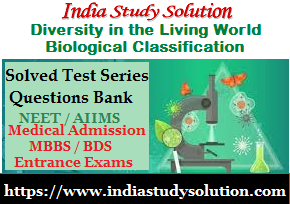Hi Friends,
Welcome back to India Study Solution (www.indiastudysolution.com)
You have landed among a series of some very important, carefully selected basic and advanced Very Short type, Medium and then Long Answer type questions followed by our very popular result-oriented India Study Solution MCQ Test Series with their answers and solutions from Biology Chapter - HUMAN PHYSIOLOGY (Breathing and Respiration, Exchange of Gases).
If you are preparing for any Medical Entrance Exam like NEET, MCAT etc. then please don't skip any question/series. Please go through the previous questions too in our earlier posts through the links given below.
If you haven't then Subscribe us to keep yourself updated. It's FREE (Subscribe button is given)
Follow us in Facebook and Twitter
Covering Syllabus: Respiratory organs in animals (recall only); Respiratory system in humans; Mechanism of breathing and its regulation in humans-Exchange of gases, transport of gases and regulation of respiration Respiratory volumes; Disorders related to respiration-Asthma, Emphysema, Occupational respiratory disorders.
HUMAN PHYSIOLOGY (Breathing and Respiration, Exchange of Gases)
India Study Solution Zoology Long Answer Theoretical Questions
TQ 4 (Q. No.68-71)
Solved Long Answer Type Biology Questions (Zoology)
Question: 68: Write the role of diaphragm in the breathing process.
Solution 68:
Breathing: Intake of fresh air from environment and expulsion of fowl air from lungs is called breathing, so there are two steps in breathing:
1. Inspiration
2. Expiration
Inspiration:
1. Intake of fresh air.
2. It is an active process.
3. Completes in 2 sec.
Inspiration occurs by contraction in inspiratory muscles, which are of two types:
(i). Radial muscles of diaphragm.
(ii). EICM.
When radial muscles contract diaphragm become flattened in shaped so volume of thoracic cavity increase between anterior and posterior surface.
When EICM contract sternum comes outward and ribs goes upward. By the contraction in both muscles volume of thoracic cavity increase and intrapulmonary pressure, decrease by 1-3 mm Hg. Therefore, environmental air enters into lungs through respiratory tract called inspiration.
Expiration:
1. Expulsion is flow of air.
2. It is a passive process.
3. It takes 3 sec.
4. Expiration occurs by relaxation in inspiratory muscles.
5. By relaxation in radial muscles diaphragm become normal dome- shape.
6. When EICM relax, then ribs and sternum comes to their normal position.
So, by relaxation on both muscles volume of thoracic cavity decrease and intrapulmonary pressure increase by 1-3 mm Hg. Therefore, expulsion of air occurs through respiratory tract called expiration.
Question: 69: What is partial pressure? How does it help in gaseous exchanges during respiration?
Solution 69: The pressure of a particular gas among the pressure of all the gases is called partial pressure. Gases move according to the pressure gradient from the higher partial pressure to lower partial pressure as follows -
Question: 70: What is chloride shift?
Solution 70: As more carbon dioxide enters into the RBC, concentration of bicarbonates in RBC is more than in plasma. Thus bicarbonate ions diffuse quickly from the RBCs into the plasma, where they are carried to the lungs. To counter balance the rapid outrush of negative bicarbonate ions from the RBCs, chloride ions (Cl–) move from the plasma into the erythrocytes. This ionic exchange process is called the Chloride Shift. After the chloride shift, potassium bicarbonate and potassium chloride are formed in the RBC while NaCl and NaHCO3 are formed in the plasma.

In the lungs, the process is reversed. As blood moves through the pulmonary capillaries, its PCO2 declines from 45 mm Hg to 40 mm Hg (and respectively from 54 vol% to 49 vol%). For this to occur, carbon dioxide must first be freed from its “bicarbonate housing.” Bicarbonate ions re-enter the RBCs (and chloride ions move into the plasma) and bind with hydrogen ions to form carbonic acid, which is then split by carbonic anhydrase to release carbon dioxide and water. This carbon dioxide, along with that released from haemoglobin and from solution in plasma, and then diffuses along its partial pressure gradient from the blood into the alveoli. This total process is referred as Hamburger phenomena.
Question: 71: Explain the terms: tidal volume, vital capacity and residual volume in relationship to respiration.
Solution 71: VC = IRV + ERV + TV
= 3000 + 1100 + 500
= 4600 ml.
Breathing and Respiration, Exchange of Gases - More Practice Questions



















